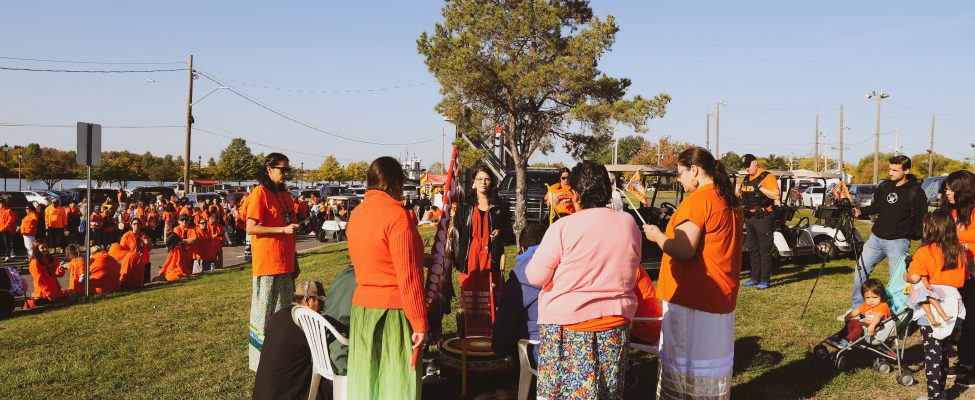The ribbon skirt represents a symbol of womanhood. It is an identifying piece that connects you to the earth and Grandmother moon. More recently, the ribbon skirt has been used as a form of expression of womanhood and strength. Many Indigenous groups have a strong tradition in this iconic piece of clothing, and all have adapted or created their own stories and protocol surrounding them. Let us look back at the core history at how the ribbon skirt began to be. This teaching is provided to us by our SGEI knowledge keeper.
Ribbon skirt origin story
There is a time in a girl’s life when they become a young woman. In the past, when a woman was experiencing her first moon time (menstral cycle). (When a woman’s body cleanses itself is often referred to as one’s moon time. In the language, this is known as being visited by one’s Grandmother – Ookomisiwin ) She would be put into a prepared and comfortable lodge and set apart from her family- out of respect. (When one is respectfully /isolated for the duration of the visit by one’s Grandmother – Makoonsiwiwin or Makoowiziwin). She would wear a ribbon skirt with colors associated with her name (and sometimes her clan). Just as one’s spirit name, this helps make her recognizable to spirits that will help and support her through this time, as well as during the duration of her life. As her body cleanses during her moon time, blood that is helping the body to cleanse will touch the earth. This creates a profound link between the Earth and who is becoming a woman. At the same time, this cycle is intimately linked with the Grandmother moon. The ribbon skirt symbolizes that connection between the women, the Earth, helpers, and the Grandmother moon.
This is evidenced in Anishinaabemowin. The word Ikwe refers to the connection between these links that are established at this time and the rest of one’s life. Kwe refers to “at this time” and “I” acknowledges that something significant is present – from this moment on, that connection to the Grandmother Moon and to the Earth is continually present and within her at any given moment.
In fact, the root of the Anishinaabe word for the vulva contains the root “aki”, meaning Earth, and describes the reciprocal connection and flow of energy to the land.
About Dorothy Friday
Boozhoo, my English name Is Dorothy Friday of the Caribou (Adik) Clan. I was born and raised In Seine River First Nation. After experiencing life-threatening trauma at Residential and Day Schools, I attended school in Atikokan with my family. In the early 1970s, there was news that The Anishinaabe people could dance and sing with others from other tribes. My parents were very excited; they took us to our first pow-wow In Red Lake, Minnesota, In 1972. Many men were standing at the higher top of the fort holding rifles; the pow-wow was inside the fort. From then on, my mother started sewing jingle dresses and ribbon skirts. She told me always to wear the ribbon skirt when in the presence of drums, pipes, feathers, and other sacred items and always when in ceremonies. My father, Bud Friday, was a gifted singer; he sang songs all his life with my grandfather, Charles Friday, his uncles, brothers, and many others. My mother was gifted in sewing ribbon skirts, shirts and jingle dresses. I followed in my mother’s footsteps, my daughter sews many cultural clothing, and my granddaughters have also picked up the wonderful world of sewing.
What are ribbon skirts to you?
Ribbon skirts are handmade skirts worn typically by Indigenous communities. Each skirt is made up of fabric and multiple ribbon colours. Ribbon skirts are most likely worn during pow-wows but can be worn daily; ribbon skirts symbolize Indigenous pride.
The ribbons represent many meanings to the individual, such as; the meaning of their Anishinaabe name and Clan colours. Many are required to wear specific colours and attire during different cultural ceremonies. Also, many ribbon skirts depict a story or are just beautiful and designed to be stylish, striking and dazzling. Most ribbon skirts have a hint of personal expression and tradition.
Skirts can tell a story. For example, in a white skirt, the colour white represents the North direction, and the ribbons on the skirt may be yellow, representing the East; red ribbons represent the South, and the West can be represented by the colours black and blue or green. This skirt tells me this person is exceptional and Ogimaakwe (Leader). There might be specific applique’ on the front of the skirt but optional.
Passing on our knowledge
There is a core ancient explanation to how the ribbon skirt came to be – evidenced in protocol, symbology, and most importantly – language. At times and in different locations, the story may change with interpretation, but looking for the evidence within the language is crucial to discover the core origin. At SGEI, we make it a purpose to pass on knowledge from the past to future generations. We will continue sharing our knowledge with you through social media and blog posts. Be sure to be following us to stay up to date.
* Jan. 4, 2023, marks the first National Ribbon Skirt Day. On this day, Indigenous women across the country are encouraged to wear ribbon skirts to celebrate their culture, strength, and connection as women.
